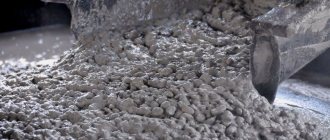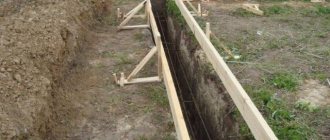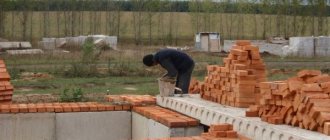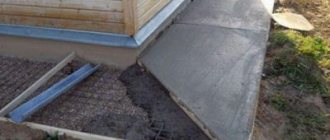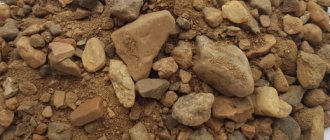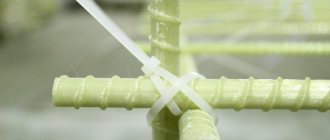Concrete is a high-strength building material that can last for several decades without losing its performance characteristics. As you know, to erect various structures, you first need to pour a concrete solution, from which the liquid gradually evaporates, due to which the mixture gradually hardens. However, in order to ensure the desired properties and eliminate the risk of surface cracking, in some cases it is recommended to wet the BSG with water.
Why do you need to water concrete after pouring?
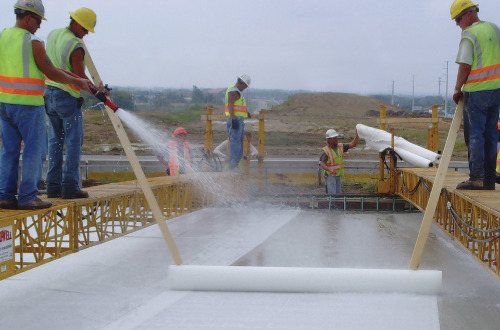
The fact is that concrete is not a homogeneous finished mass, but a mixture of fine (sand) and coarse aggregate (crushed stone or gravel), as well as water, special additives (not always present) and the main binding element - cement. During hardening, water and cement, which contain 5-7% and 10-13% in the total mass, respectively, envelop the aggregate grains. Then, over time, the volume of the poured concrete structure itself changes. As the water evaporates, the binder hardens and, binding the grains, makes the structure solid and monolithic.
In general, the technology requires 28 full days for the foundation to completely harden, although walls begin to be erected after 2-3 weeks. However, usually, under the influence of temperature, the top layer hardens much faster than the middle and especially the bottom. When this happens, microcracks occur, greatly reducing the service life of the structure. This becomes most noticeable during the cold season, since water can accumulate in them, and after freezing, it breaks the concrete. Over time, small cracks turn into larger ones.
Why is moisturizing a concrete foundation important?
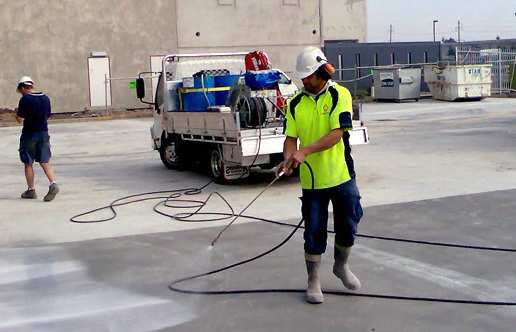
Process of moistening concrete foundation
- Water participates in all physical and chemical processes, so it is quickly neutralized. But the concrete does not have time to gain the necessary strength and moisture loss must be compensated;
- Moisture condenses faster from the open surface of concrete, and therefore exchange processes occur there weaker. As a result, an unstable hard surface is formed, which immediately collapses under load. And underneath there is a liquid layer of concrete, which simply did not have time to gain its strength;
- When concrete hardens, it decreases in volume, therefore, to compensate for losses, it is necessary to use water to activate metabolic processes inside the structure. But here you need to strictly dose the amount of water, taking into account temperature conditions and climate;
- The key factor is climate. If the air is warm enough, then the moisture evaporates much faster than necessary. As a result, little moisture remains in the concrete, it is not enough for metabolic processes and a pure cement structure is formed. It is not able to withstand even minor loads; it is loose and porous. And if you add wind to this, the foundation will quickly erode and a large number of cracks will appear.

It is these microcracks that are especially dangerous. They destroy concrete, because through them rainwater, as well as dust and dirt, gets inside. As a result, the outer surface remains intact, but concrete destruction occurs inside. Cracks are especially dangerous in winter with sudden temperature changes.
Due to the ingress of moisture, water is converted into ice, which expands and enlarges the crack, after which the concrete fragment swells and breaks off. In fact, this is a chain reaction that ends up completely destroying the foundation.
How often should concrete be watered after pouring?
As a last resort, the procedure is performed 10 hours after the end of concreting, but only if the weather permits. In very hot or windy weather, the first watering should be done after 2-3 hours. You need to water the foundation day and night, constantly keeping the top layer moist. If the weather is very hot or windy, watering should be done every 1.5-2 hours, increasing the interval in the morning, evening and night. The weather can be considered hot when the temperature in the sun is more than 15 degrees. At an air temperature of 15 degrees, you need to water every 3-4 hours during the day and 1-2 times at night. If the weather is 5 degrees or less, then there is no need to water the concrete.
In theory, you can make a schedule from these 3 points and water according to it, but it is much more reliable to touch the concrete to understand whether it is wet enough or not. If it is not possible to water frequently on a schedule, then you can apply a layer of wet sawdust, roofing felt to the surface, or shade the area. Also, the concrete should be covered with plastic film so as not to increase the interval between waterings, and this will also have a positive effect on the result.
Rules of care
Maintenance of the foundation after pouring is completed after reaching at least 65% of the strength or the time for stripping, for which there are technical grounds. First of all, after concreting, you need to examine the formwork itself for damage that could cause the mixture to leak out and, accordingly, deform the base. If damage is discovered, they should be repaired immediately before the concrete has time to set. Approximately the mixture hardening time is up to two hours.
While the foundation is solidifying, it should not be shaken or subjected to any other type of mechanical impact. It is recommended to cover the structure with polyethylene film after pouring. This will help avoid the possibility of erosion.
Maintaining optimal humidity and temperature conditions is an important stage when caring for a concrete mixture. The mixture must be kept at a humidity of 90−100%.
It is worth noting that early dehydration does not have the best effect on the concrete mixture. This phenomenon is mainly observed in the case of leakage of the water component from the solution, which occurs as a result of damage to the formwork. As a result, various troubles are possible, which are expressed in a decrease in strength and even separation of sand. Shrinkage cracks occur, which results in a sharp decrease in the volume of the mixture in open areas. This occurs due to rapid weathering.
Surface cracks, which form first, quickly spread deeper. This creates an even greater threat to the entire structure. Therefore, it is recommended to extend the drying period until the base reaches the required level of strength.
In windy weather, concrete dries much faster; this must be taken into account. The drying rate is also affected by the level of humidity and temperature. After 8 hours, it is necessary to regularly moisten the foundation. In this case, diffuse watering is used. In addition, it is possible to protect the hardening concrete mixture with a layer of sawdust. You can also cover the structure with tarpaulin or burlap. The materials used for protection are constantly wetted to create wet compress conditions.
It is important to remember that measures to moisten the concrete mixture are carried out only if the average daily temperature is above +5 degrees. If there is a possibility of frost, the foundation is covered with mineral wool, rags or other heat-insulating materials
If constant moisture is not possible, the concrete is covered with a polymer film. It is necessary that the thickness of this material be above 200 microns. The main thing to achieve is to minimize the number of joints. They are glued with adhesive tape or using a special tape.
To ensure that the still fresh concrete is not damaged by groundwater, everything possible must be done to prevent it from being washed away. When the mixture becomes stronger, it will be more difficult to wash it away. Typically, the required strength is achieved 3-4 days after pouring. Concrete maintenance, as noted by ENR, is completed after formwork is removed.
How many days to water concrete after pouring?
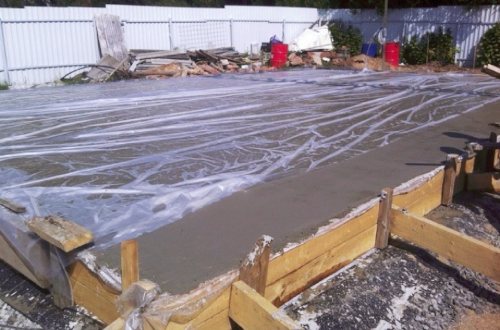
Watering should be continued until the lower layers of the foundation are completely hardened. Experienced builders do this intuitively, but novice craftsmen are better off sticking to certain parameters.
The hardening time is most influenced by:
- Type of construction . The greater the percentage of the area exposed to direct sunlight, the faster hardening occurs throughout the entire volume.
- Type of cement . Different brands harden at different rates, so you need to carefully read the instructions for use.
- Climatic conditions . During the cold season, concrete hardens equally throughout its entire volume.
The direct speed of cement hardening also affects:
- Rapid hardening cement hardens within 8 days
- Portland cement hardens longer - about 2-3 weeks
- If the structure is based on cement, which hardens gradually, then the structure should be wetted for all 4 weeks.
The timing of maintenance of the structure is influenced by the time of year and, accordingly, the temperature:
- 15 degrees and above . This weather is considered hot, during which the top layer of the foundation hardens much faster. In such cases, concrete needs to be watered for 7 to 15 days.
- 10 degrees and above . This weather is considered normal. With it, the duration of watering is reduced to 5-10 days.
- 5 degrees and below . Low temperature, usually characteristic of the cold season. There is no need to water as the concrete hardens evenly.
In general, watering must be done until the structure reaches 70% strength. Usually this takes 10 days, but depending on weather conditions, the period may decrease or increase. Watering should not be carried out beyond the established period, since excessive moisture can, on the contrary, slow down the rate of hardening.
Do you water the concrete after pouring?
Yes
No
Need for hydration
Scheme of waterproofing a monolithic concrete foundation.
Many novice builders, having poured concrete on an object themselves, mistakenly consider the work to be finished. And they are deeply mistaken, since quite a long time passes from pouring to the final gain of concrete strength. Typically, after 2-3 weeks, depending on ambient temperature and weather conditions, the poured concrete becomes strong enough to withstand significant pressure on its surface. Those. if we are talking about a poured foundation, then after this period of time you can remove the walls of the house. According to laying technology, the standard period of time for concrete to gain strength is 28 days, although concrete to gain strength can continue for years.
It is imperative to take into account the fact that, when concrete hardens, it has the unpleasant property of changing its volume. For a concrete structure to be of high quality, the concrete must gain strength. He gains it by evaporating moisture, and evaporation should occur evenly from the entire volume of concrete masonry. But at high temperatures or strong winds, the outer layer of a concrete structure releases moisture faster than the middle. When drying, it develops a sediment, and the faster it dries, the greater the sediment.
The consequence of this settlement, which is especially unpleasant for builders, is the appearance on the surface of the poured concrete structure of areas with a large number of small cracks.
Scheme of a concrete floor on the ground.
Once the concrete structure has fully cured, these little rascals are sure to show their vicious nature by helping unfavorable conditions destroy the integrity of the concrete. They are especially zealous in winter, when the moisture collected in the cracks freezes and simply tears the structure, weakening it and significantly reducing its service life. This is most noticeable when such a nuisance happens to the concrete foundation of a building. It gives off weakness, as a result of which far from small cracks may appear along the facade of the building, which, if the foundation is not strengthened, will only increase over time.
But that's not all. If the top ball of concrete is too dry, it stops a process called cement hydration. As a result, concrete gains strength too slowly. Simply put, the strength of the finished concrete will not correspond to the planned grade; it will be much lower.
To avoid this problem, it is necessary to regularly wet the concrete until it hardens completely. It is important to understand that no matter how much we pour water on concrete, we do not make it stronger, but simply prevent it from becoming more brittle. If the concrete structure is sufficiently wet during its hardening, then the settlement of the concrete will occur quite slowly, and accordingly, the stress on the surface of the concrete structure will be quite weak. In other words, if the surface of a concrete structure is constantly moistened until it reaches its full strength, then the probability of temperature-sediment cracks appearing on its surface will approach zero.
Watering instructions
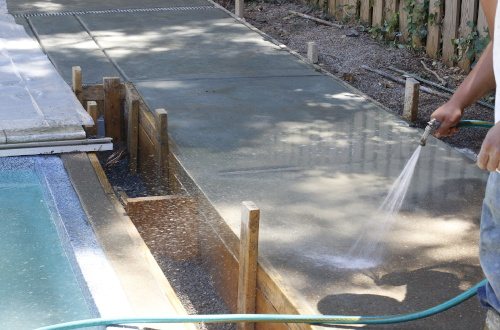
Tips on how to properly water concrete after pouring:
- Not only the surface, but also the base of the concrete structure should be irrigated.
- Distribute water evenly over the surface.
- Cover the concrete surface with a film so that less water evaporates.
- Particular attention should be paid to concrete joints (edges and nodes), where water evaporates faster, and therefore chips and cracks are more likely to appear.
- Use a sprayer for better surface coverage.
- Do not allow complete evaporation of moisture from the surface.
- When using water from a nearby reservoir, it is recommended to use a pump instead of ordinary buckets. The fact is that the amount of water required is quite large and it will be very difficult to carry it in buckets.
Covering the screed with polyethylene
The new screed should be covered with plastic wrap and left for a day. This is done in order to limit the evaporation of water from the screed. The water should react uniformly with the cement in the mortar and also evaporate evenly from the mortar.

After 24 hours, the installed beacons must be knocked out of the screed. The grooves (grooves) from the beacons must be cleaned and sealed with the same solution that was used to make the screed itself. Filled furrows must be repaired immediately.

